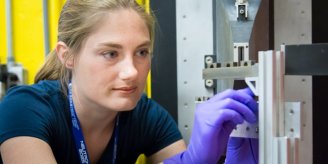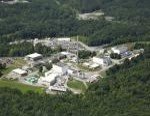Copyright 2012 neutronsources.org | All rights reserved. | Powered by FRM II | Imprint / Privacy Policy
Unlocking Potential of 3D Printed Rocket Parts with Neutrons
Date: 14/09/2016
Source: neutrons.ornl.gov

The process of 3D printing, or additive manufacturing, holds promise for advancements in almost every industry, including even rocket science. Engineers from NASA’s Marshall Space Flight Center in Huntsville, Alabama, used neutrons recently to help understand the potential benefit of additive manufactured rocket engine components.
The team used the Neutron Residual Stress Mapping Facility at Oak Ridge National Laboratory’s (ORNL) High Flux Isotope Reactor (HFIR), beam line HB-2B, to study residual stress in additive manufactured materials with hopes of qualifying them for flight, which could significantly reduce cost and schedule of flight hardware component manufacture.
“Using the additive manufactured version of one engine component we are studying could reduce the amount of time needed to build a space-flight ready engine by years,” said Stacey Bagg of NASA Marshall.
Such a significant time reduction means major cost savings for the project. But before a component can be used for space flight, the team needs to be sure it’s safe.
“Of particular concern are the residual stresses in the resulting additive manufactured components, as residual stresses may affect material properties and resultant part geometries and are difficult to measure on the resulting complex shapes,” said Bagg. “The HFIR neutron residual stress facility provides the unique capability to take detailed internal residual stress measurements on these shapes.”
This research also provides fundamental data providing insight into how residual stresses develop around common features of rocket propulsion components during the additive manufacturing process. The team’s research will be made publicly available and may be used to improve processes and controls for powder-bed additive manufacturing such that components exhibit improved mechanical and geometric properties.
This work was supported by NASA’s Game Changing Development Program, Advanced Manufacturing Technology Project’s Materials Genome Initiative (MGI) element.
HFIR is a Department of Energy Office of Science User Facility. UT-Battelle manages ORNL for the DOE’s Office of Science. The Office of Science is the single largest supporter of basic research in the physical sciences in the United States, and is working to address some of the most pressing challenges of our time. For more information, please visit http://science.energy.gov/.
View additional photos: https://flic.kr/p/MbZrWF
Further information:

